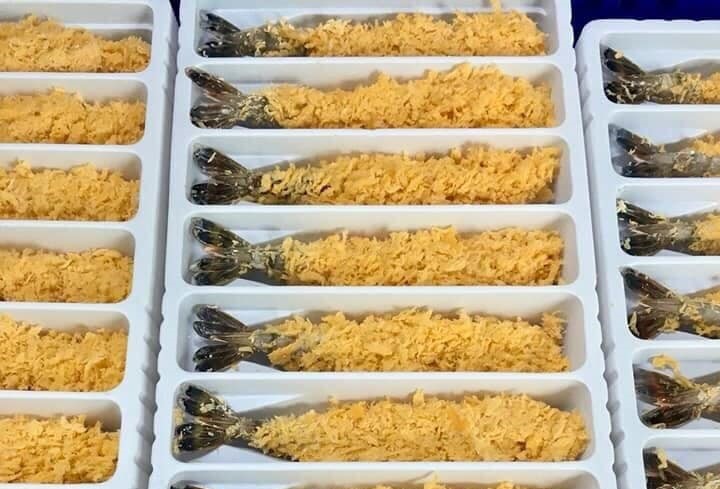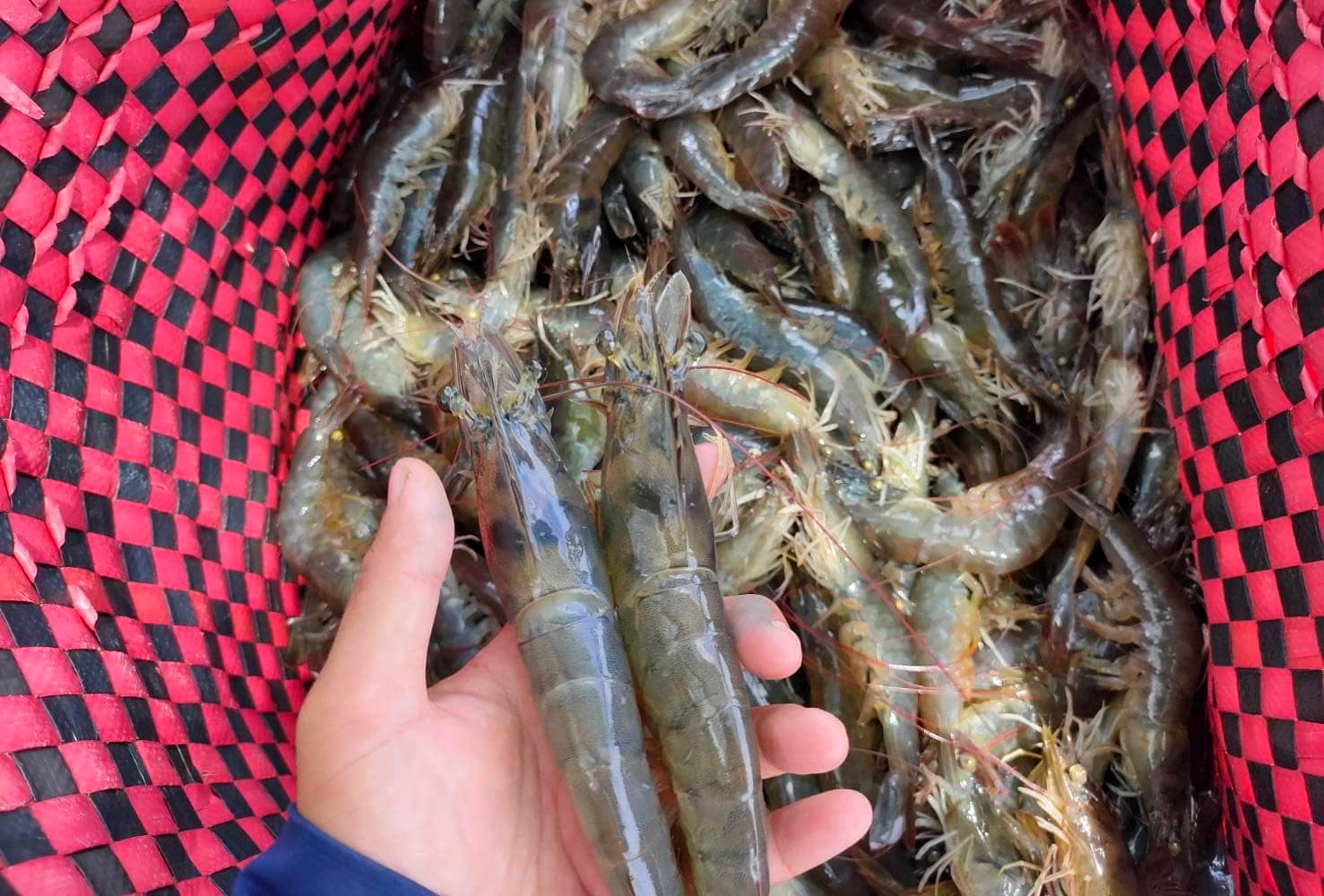November 27, 2025 | 23:44 GMT +7
November 27, 2025 | 23:44 GMT +7
Hotline: 0913.378.918
November 27, 2025 | 23:44 GMT +7
Hotline: 0913.378.918

A Vietnamese deep-processed shrimp product. Photo: Son Trang.
Due to their higher prices compared to shrimp from many other countries, including Ecuador and India, Vietnamese shrimp have long faced various disadvantages in the global shrimp market. According to the Foreign Agricultural Services Agency under the US Department of Agriculture, the price of Vietnamese shrimp imports into the US averaged at 10.7 USD per kilogram in the first quarter of 2023. On the other hand, the average price of imported Indian shrimp is 8.2 USD per kilogram; Ecuadorian shrimp 6.7 USD per kilogram.
In recent years Vietnam's shrimp industry has focused on strong key products such as large-sized shrimp and deep-processed shrimp within the last few years in order to compete in the global market.
According to Dr. Ho Quoc Luc, Chairman of the Board of Directors of Sao Ta Food Joint Stock Company, the price of large-sized shrimp exports from Vietnam decreased by 30% in 2023. The rapid growth of large-sized shrimp farming in countries around the world has led to this decline. This change has consequently increased the amount of large-sized shrimp produced.
Another strength in Vietnam's shrimp industry is its processing capacity. Vietnam and Thailand currently possess the highlest level of processing capacity in the shrimp processing industry, out of the six largest shrimp exporting countries around the world. As a result, despite the strong competitive pressure caused by affordable shrimp from India and Ecuador, Vietnamese shrimp has maintained its ground in the global market, even obtaining the largest market share in many fastidious markets.
Information from the Vietnam Association of Seafood Exporters and Producers (VASEP) shows that processed shrimp accounted for 40% of the total value of Vietnamese shrimp exports to Australia within the first eight months of 2022. With these figures, processed shrimp has made a substantial contribution to helping Vietnam's shrimp exports to Australia reach 272 million USD in 2022, which is an increase of 44% compared to that of 2021. Subsequently, Vietnam's shrimp exports continue to hold the largest market share in the Australian market.
Regarding the Japanese market, Vietnamese shrimp has maintained a largest market share, including a a significant contribution from deep-processed products. The Japanese market requires delicate and meticulous processing techniques which are met by the processing capacity of Vietnamese shrimp production businesses.

Freshly harvested shrimp in Can Gio district, Ho Chi Minh city. Photo: Son Trang.
VASEP reported that Vietnamese shrimp products processed for export to Japan retain an advantage over other markets. Vietnam's key exports to Japan consist of products such as frozen breaded shrimp, frozen steamed black tiger shrimp, breaded shrimp, frozen PDTO Nobashi vannamei, frozen steamed black tiger shrimp, frozen steamed white leg shrimp with tail, frozen steamed shrimp with head and tail removed, frozen steamed white shrimp among many others.
According to Dr. Ho Quoc Luc, although shrimp exports faced numerous challenges within the first half of 2023, Vietnamese shrimp still dominated with the largest market share of deep-processed products in major markets around the world.
However, other major shrimp exporting countries are also making great efforts to improve their shrimp processing capacities. As a result, Dr. Ho Quoc Luc suggested Vietnam's shrimp industry to continue enhancing its processing level, with a product strategy that focuses on higher development steps. For example, there are highly complex processed shrimp products that can potentially attract more customers compared to basic products. Regarding the strong and near-monopolistic areas in the Vietnam's shrimp industry, they must also be continually strengthened and improved to maintain their positions in the global market.
According to the Ministry of Agriculture and Rural Development, the shrimp industry faced countless difficulties in the year 2022. Most notably, the Covid-19 pandemic as well as the conflict between Russia and Ukraine has had a strong impact on the global value chain. Consequently, fuel prices are unstable, whereas prices of materials, petrol and aqua feeds rapidly rose.
Thanks to the drastic and effective direction from the Government, Prime Minister, local governments as well as the active participation of guilds and associations; the efforts of fishermen across Vietnam, the results of shrimp farming in 2022 were remarkable. Accordingly, the export turnover of Vietnamese shrimp reached approximately 4.3 billion USD in 2022, which is the highest figure ever recorded.
Translated by Nguyen Hai Long

(VAN) According to Mr. Vo Minh Thanh, Director of the Tay Ninh Department of Agriculture and Environment, Resolution 57 has created a new development pathway for the locality, shifting from traditional toward modern agriculture.
/2025/11/26/4909-2-154329_878.jpg)
(VAN) Pearl grouper farming in HDPE cages not only delivers economic efficiency but also contributes to protecting the environment, creating jobs, and promoting marine-based experiential tourism.

(VAN) The model of making a living under the forest canopy through the agroforestry system in Van Son commune, Bac Ninh province, is expected to generate an annual income of approximately VND 30 million/ha.

(VAN) Many enterprises in Can Tho are harnessing natural energy and reducing greenhouse gas emissions in their production processes, thereby contributing to the promotion of a sustainable green transition.
/2025/11/24/3536-2-112800_176.jpg)
(VAN) Dong Nai now has tens of thousands of hectares of forests certified for sustainable management, and this area will continue to be expanded in the coming period.

(VAN) Vinh Ha hamlet (Dai Xuyen commune, Hanoi) is shifting away from small-scale farming as households adopt bioscurity into their breeder chicken models.

(VAN) Heavy rains make aquatic species more vulnerable to disease. Proactive water management and high-tech systems help farmers prevent outbreaks and protect yields.